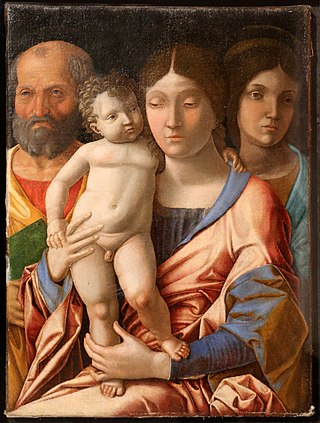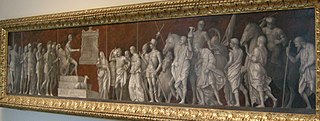
Andrea Mantegna was an Italian painter, a student of Roman archeology, and son-in-law of Jacopo Bellini.

St. Sebastian is the subject of three paintings by the Italian Early Renaissance master Andrea Mantegna. The Paduan artist lived in a period of frequent plagues; Sebastian was considered protector against the plague as having been shot through by arrows, and it was thought that plague spread abroad through the air.

The San Zeno Altarpiece is a polyptych altarpiece by the Italian Renaissance painter Andrea Mantegna created around 1456–1459. It remains in situ in the Basilica di San Zeno, the main church of the Northern Italian city of Verona. Mantegna's style mixes Greco-Roman classical themes along with Christian subjects in this altarpiece. The central panel, along with the three paintings that comprise the predella, were taken in 1797 by the French. While the main, central scene was returned by the French to Verona in 1815, the three predella paintings in Verona today are copies, since the original ones remain in France at the Louvre (Crucifixion) and in the Musée des Beaux-Arts in Tours. The paintings are made with tempera on panel; not oil as mistakenly identified in one source.

Francesco Bonsignori, also known as Francesco Monsignori, was an Italian painter and draughtsman, characterized by his excellence in religious subjects, portraits, architectural perspective and animals. He was born in Verona and died in Caldiero, a city near Verona. Bonsignori's style in early period was under the influence of his teacher Liberale da Verona. After becoming the portraitist and court artist to the Gonzaga family of Mantua in 1487, his style was influenced by Andrea Mantegna, who also worked for Francesco Gonzaga from the 1480s. They collaborated to execute several religious paintings, mainly with the theme of Madonna and Child. The attribution of theportrait of a Venetian Senator was debatable until the last century because of the similarity in techniques used by Bonsignori and his teacher Mantegna. During the phase of his career in Mantua, there is an undocumented period between 1495 and July 1506 with no official record regarding his activities by the court of Mantua. Bonsignori's late style was decisively influenced by Lorenzo Costa in terms of form and color. He produced his last monumental altarpiece the Adoration of the Blessed Osanna Andreasi in 1519 shortly before his death.

The Ovetari Chapel is a chapel in the right arm of the Church of the Eremitani in Padua. It is renowned for a Renaissance fresco cycle by Andrea Mantegna and others, painted from 1448 to 1457. The cycle was destroyed by an Allied bombing in 1944: today, only two scenes and a few fragments survive, which have been restored in 2006. They are, however, known from black-and-white photographs.

The Parnassus is a painting by the Italian Renaissance painter Andrea Mantegna, executed in 1497. It is housed in the Musée du Louvre of Paris.

The Allegory of Vice is an oil on canvas painting by Correggio dating to around 1531 and measuring 149 cm (59 in) by 88 cm (35 in).

The Allegory of Virtue is an oil on canvas painting by Correggio dating to around 1531 and measuring 149 by 88 cm. It and Allegory of Vice were painted as a pair for the studiolo of Isabella d'Este, with Vice probably the second of the two to be completed. This hypothesis is since only one sketch survives for Vice, unlike Virtue, for which two preparatory studies survive, along with a near-complete oil sketch - this suggests Correggio had become more proficient after the difficult gestation of Virtue.

Holy Family with Saints Elizabeth and John the Baptist is a fragment of fresco from the Basilica of Sant'Andrea, Mantua, now held in Mantua's Diocesan Museum. It was painted ca. 1509–1511 by the Italian Renaissance painter Correggio and is 1.5m in diameter. It shows the Virgin Mary, the Christ Child, St Joseph (right), St Elizabeth (left) and the infant John the Baptist.

The Mantegna funerary chapel is one of the chapels of the Basilica of Sant'Andrea, Mantua. It houses the tomb of the painter Mantegna and his last two paintings – Baptism of Christ and Holy Family with St John the Baptist, St Elizabeth and St Zacharias (1504–1506). Its frescoes from 1507 were painted by his sons Ludovico and Francesco and by a young Correggio. The tomb bears a bronze figure of Mantegna by Gianmarco Cavalli.

St Jerome in the Wilderness is a tempera on panel painting, measuring 48 by 36 cm and attributed to Andrea Mantegna. It dates to between 1449 and 1450 and is now in the São Paulo Museum of Art.

Saint George is a 66 by 32 cm tempera on panel painting by Andrea Mantegna, dated to around 1460 and now in the Gallerie dell'Accademia in Venice. It shows the saint in armour and on foot, carrying the remains of the lance he has used to kill the dragon, who lies at his feet with the lance's point stuck in its jaw. There is a marble border down the left and right hand sides of the painting, though George's elbow protrudes over the left hand border and the dragon's head over the right-hand border - such illusions were a signature trait of Mantegna's work, especially between the end of his Paduan period and the start of his time in Mantua. The garland at the top is a typical motive of the Squarcione school, referring back to Mantegna's time in Squarcione's studio in Padua during his youth, whilst in the right hand background a road leads to a walled hilltop city.

The Holy Family and the Family of Saint John the Baptist is a casein tempera on canvas painting with gilding, measuring 40 by 169 cm and dating to around 1504-1506. It was painted by Andrea Mantegna and was mentioned by his second son Francesco as still being in Andrea's studio on his death in 1506. According to Andrea's wishes, both it and Baptism of Christ were assigned to his funerary chapel in the Basilica of Sant'Andrea, Mantua, where they still hang. The choice of theme is linked to the chapel's dedication to John the Baptist.

The Baptism of Christ is a casein tempera and gold on canvas painting measuring 176cm x 230cm and dating to around 1506. It and The Holy Family and the Family of Saint John the Baptist were painted by Andrea Mantegna for his funerary chapel at the Basilica of Sant'Andrea, Mantua - the chapel was dedicated to John the Baptist, hence the choice of subjects. They were both found in his studio after his death by his son Francesco and placed in the chapel, where they still hang.

The Altman Madonna or 'Holy Family with St Mary Magdalene is a glue-tempera and gold on canvas painting, measuring 57.2 by 45.7 cm and dating to 1495-1505. Painted by Andrea Mantegna, it is now in the Metropolitan Museum of Art in New York.

The Holy Family with a Female Saint is a 1495–1505 tempera on canvas painting attributed to Andrea Mantegna - the lose of the original finish and re-painting means that the painting itself cannot be securely attributed to him, though the silverpoint under-drawing is definitely in the master's hand. To the left is saint Joseph and to the right is an unidentified female saint, possibly Mary Magdalene.

The Madonna and Child with Three Saints is a 1490-1500 tempera on canvas painting attributed to Andrea Mantegna, now in the Musée Jacquemart-André in Paris. Heavily damaged, not all art historians attribute it as an autograph work. If it is, it belongs to a group of small-format Madonnas for private devotions, which also includes Holy Family with Saints Anne and John the Baptist (Dresden), Holy Family with a Female Saint (Verona) and Madonna and Child with Saints (Turin). The Madonna's face touches that of her son in a manner reminiscent of the Madonna with Sleeping Child (Berlin). To the left is a female saint, possibly Mary Magdalene, whilst to the right are saint Joseph and another unidentifiable male saint.

The Continence of Scipio or An Episode from the Life of Publius Cornelius Scipio is a painting in oils on canvas by the Italian Renaissance artist Giovanni Bellini, dating to 1507–08 and now in the National Gallery of Art in Washington, D.C.

Pietà or The Dead Christ Supported by the Virgin Mary and St John the Evangelist is a c. 1465–1470 tempera-on-panel painting by the Italian Renaissance artist Giovanni Bellini, now in the Pinacoteca di Brera in Milan.

Madonna and Child with Saints is an oil-on-panel painting by Lorenzo Lotto, signed "L. Lotus F.[ecit]", and created c. 1505. It was first definitively recorded in 1727, when it was in France in the Orléans Collection. It is now in the Scottish National Gallery in Edinburgh. It is in the Holy Conversation style – on the left are a male saint and Saint Peter, whilst to the left are a female saint and Francis of Assisi.




















